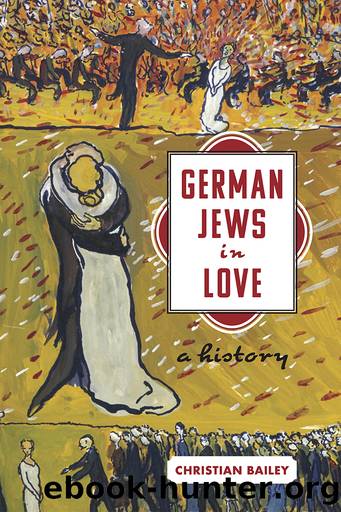German Jews in Love by Christian Bailey;

Author:Christian Bailey;
Language: eng
Format: epub
Publisher: Stanford University Press
Published: 2022-06-15T00:00:00+00:00
FIGURE 5. Advertisement in Šalom na Pátek (Shalom on Friday), November 26, 1943. Source: Yad Vashem, O.64/64.
Romantic relationships certainly helped some ghetto dwellers to cope, providing them with solace and sometimes protection.118 In a memoir called âShakespeare Saved My Life,â one Theresienstadt survivor, Eva Rocek, wrote of how a romantic relationship with an equally intellectually ambitious boy allowed her to mentally inhabit a counterworld full of great works by Dante, Goethe, and French poets that was far removed from the squalor of everyday existence.119 Her account was echoed by the testimonies of numerous former ghetto inhabitants who participated in Steven Spielbergâs Survivors of the Shoah Visual History Foundation project.120 Nevertheless, romantic relationships more generally were marked by the Darwinian social logic encouraged by the Nazis in mainstream society. Desire, particularly male desire, was never altogether extinguished, but it was usually satisfied by instrumental sex that was offered predominantly by women in exchange for other vital commodities such as bread. This, at least, is the conclusion drawn by Anna Hájková, whose project on Theresienstadt describes sex as one commodity within a desperate barter economy.121 In this economy men who produced foodstuffs, such as bakers, or those who could allocate housing were the most desirable partners.122 But being able to feed oneself and others did not just mean that a man offered practical advantages to a prospective sexual partner. It also meant that he would have been more likely to have maintained his sex drive and would have appeared more physically healthy. This was, for instance, particularly true of the few Danish Jews in Theresienstadt who received care packages throughout their time in the ghetto.123
Hájková also suggests that in the sexual economy of the ghetto, women were producers who used their emotional and physical labor and their human capital to secure other goods for themselves and their relatives.124 (This is not to overlook the numerous incidences of rape that occurred, which remain âunderexplored and increasingly hard to uncover,â as Zoë Waxman has explained.)125 By contrast, men, who usually had better jobs than women, were largely consumers of intimacy who traded other products for the precious commodity of sex and affection. For those men the ability to have sex with a woman and to display her as a kind of girlfriend not only satisfied a basic physical desire but also became a symbol of high status among those who had lost many other markers of prestige or social standing.126
Perhaps because sex became so commodified in the ghettos, a young woman such as Rocek could insist on maintaining the purity of her romantic relationship in Theresienstadt, first crying to her mother when the boy who would become her husband kissed her after a second or third date. Throughout their courtship, Rocek âvehemently refusedâ when her partner tried to sit her on his lap. So chaste did the relationship seem that Rocekâs father joked that the couple would spend their wedding night reading poetry.127
Another column that appeared in Šalom na Pátek in early 1944 conveyed
Download
This site does not store any files on its server. We only index and link to content provided by other sites. Please contact the content providers to delete copyright contents if any and email us, we'll remove relevant links or contents immediately.
Room 212 by Kate Stewart(4732)
The Crown by Robert Lacey(4571)
Endurance: Shackleton's Incredible Voyage by Alfred Lansing(4502)
The Iron Duke by The Iron Duke(4119)
The Rape of Nanking by Iris Chang(4022)
Killing England by Bill O'Reilly(3896)
Joan of Arc by Mary Gordon(3782)
Say Nothing by Patrick Radden Keefe(3725)
I'll Give You the Sun by Jandy Nelson(3270)
Shadow of Night by Deborah Harkness(3173)
Hitler's Monsters by Eric Kurlander(3161)
Mary, Queen of Scots, and the Murder of Lord Darnley by Alison Weir(3062)
Blood and Sand by Alex Von Tunzelmann(3055)
Darkest Hour by Anthony McCarten(3017)
Margaret Thatcher: The Autobiography by Thatcher Margaret(2969)
Eleanor & Park by Rainbow Rowell(2943)
Red Famine: Stalin's War on Ukraine by Anne Applebaum(2814)
Book of Life by Deborah Harkness(2717)
The One Memory of Flora Banks by Emily Barr(2684)
